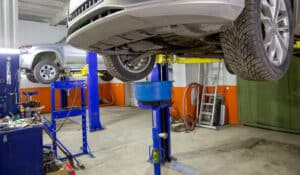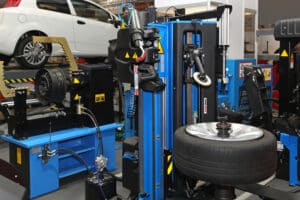Body Shop Health & Safety: Looking After Yourself & Your Team
Health and safety precautions are a must in body shops and car garages of all kinds, regardless of the machinery you own and the size of your business. As a manager, it’s not just a legal requirement but also a moral obligation to guarantee the safety of your team at all times. It’s important to take all necessary measures to maintain the wellbeing of your employees, since failure to do so could lead to legal action or absences because of serious but preventable injuries.
Whether you’re starting the process of opening a body shop or have been running a successful automotive repair business for a while now, it’s always a good idea to brush up on health and safety rules, regulations and advice. Here, we’ll guide you through our checklist so you can tick off all the main safety precautions within your body shop.
Body Shop Health & Safety Hazards
Every body shop is different, which typically means that there could be a variety of risks and hazards involved. Below, we’ll list the most common hazards and explain the risks these could pose for your employees and general business operations.
- Lifts: Improper use could lead to collapsing of the lift, which could result in serious injuries, damage to the repair shop or the equipment itself and liability claims.
- Jacks: By not checking that the jack is in place correctly or is in good working condition, there is a risk that a vehicle could fall and injure workers.
- Machinery: Machinery poses many risks. From getting caught in the moving parts to hazards like an electric shock, various body shop machinery can be dangerous when used without proper knowledge, care or understanding.
- Abrasive wheels: Although these are excellent tools for body shops, the risk of injury is high when using this piece of equipment. Body shop workers are at risk of cuts, scrapes and more serious injuries depending on the speed and materials used.

- Vices: Employees can become stuck in a vice or sustain injuries on the moving parts.
- Painting: Paint itself may contain harmful substances that shouldn’t be inhaled or touch skin, while the paint guns themselves can cause injury due to the force they can exert.
- Drills and power tools: While improper use can cause serious wounds, the equipment should also be kept in good working condition to prevent electric shock.
- Trips, slips and falls risks: Trailing leads, equipment trolleys and spilt substances can all contribute to trips, slips and fall risks.
- Electrical hazards: From electrical car components to electrical equipment in the shop, multiple items could pose an electrical hazard. Damaged cables from lack of care and improper handling of electrical components can all cause electric shock in employees.
- LPGs: These must be stored correctly in a cage and kept away from flames, otherwise the hazardous substances could cause serious injuries and damage to the property.
- Chemicals, fumes and irritants: Without the correct protective equipment, employees could expose themselves to harmful chemicals, fumes and irritants. These can cause burning of the skin or even lead to serious breathing problems.
- Burns: When using high bake ovens, there’s always a potential risk of burn injuries.
- Cuts and abrasions: When using machinery and tools or handling sharp-edged car panels, these tasks can all result in cuts and abrasions for your body shop workers.
- Manual handling: Handling any equipment or items in the body shop should require extra considerations such as how many people are needed to lift something and whether protective equipment should be worn. Failure to consider any risks could lead to dropping items and injuring yourself or others.

Body Shop Safety Checklist
Unsure of the precautions to take in your body shop? Our checklist below will take you through everything you should be doing, from training to equipment requirements.
Risk Assessments
Carrying out car body shop risk assessments is one of the very first steps that should be taken by managers. A risk assessment should clearly state the potential risk, the likelihood of it happening, who it could affect, and the measures in place to help prevent it.
Although all businesses are required to carry out thorough risk assessments, additional requirements should be met for any body shop with five or more employees. This includes creating a written-up health and safety policy and recording results of risk assessments with details of any employees that are at higher risk.
Machinery Training
Machinery can be excellent for creating more efficient processes and speeding up lengthy or complicated repair jobs. However, without proper inductions, training and checks on all the machinery, employees won’t be fully prepared to use the machinery in the safest manner. As a result, this can lead to dangerous situations where body shop employees are likely to injure themselves or others.
Some specialist machinery might also require additional qualifications to use, and these should always be checked over by a manager to ensure that the employee is safe to use the equipment.
Product Training
Training on product usage should be a priority because many products used in body shops pose health and safety risks. For example, some automotive paint types may contain hazardous substances which employees should be briefed on before using. This is in compliance with the Control of Substances Hazardous to Health regulation (COSHH), which covers everything from toxic to explosive substances. By training your employees on the correct ways to handle the products used and explaining the risks involved, you’re setting your body shop up for minimal accidents.

Use of Correct PPE
Personal protective equipment (PPE) is essential in this industry to prevent injuries, accidents and any other workplace issues. And while PPE is often encouraged, the correct use of it isn’t always enforced. Safety equipment and items like safety glasses, ear plugs, knee pads, first aid kits and paper suits should be provided by the employer who should then show their employees the correct way to wear or use each item.
Since a manager’s role is to ensure all body shop employees are kept safe, the responsibility of purchasing and distributing the PPE falls to them. However, everybody in the body shop from employees to managers should take on the responsibility of checking that it’s being used correctly. Whether this means holding a training session, regularly checking that everybody understands when, where and how to use their PPE or just giving regular reminders – this is one of the easiest ways to maintain safety amongst your employees and ensure you’re meeting regulations.
Health & Safety Employee Education
The right education can transform how you and your employees view body shop health and safety. Making sure this is included in onboarding and future training for every employee new and old is essential since a good understanding of health and safety will boost confidence in your policies and methods.
The dangers of potential hazards should always be laid out clearly in order to comply with the Health and Safety at Work Act 1974. This Act states that all employers must provide a safe working environment for all employees, and providing education on health and safety best practices is one of the best ways to guarantee this.
Looking after your team and doing your best to avoid typical body shop health hazards should always go hand-in-hand. Our checklist and comprehensive guide to the most common risks can help you ensure your shop is well-managed and complies with all health and safety requirements.
At JTAPE, we’re dedicated to providing car garages and body shops with the tools they need to mask off their cars for many automotive repairs. Visit our online store to discover the full range, or contact us to find your local distributor.


